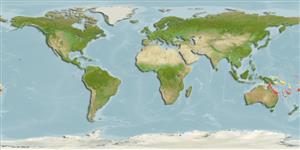Teleostei (teleosts) >
Kurtiformes (Nurseryfishes, cardinalfishes.) >
Apogonidae (Cardinalfishes) > Apogoninae
Etymology: Taeniamia: Name from feminine Latin noun 'taenia' meaning ribbon or band; and feminine Greek noun 'Amia' meaning a fish, often used with cardinalfishes genera. Here as Taeniamia referring to the vertical wide bars and near vertical to curved narrow bars as lines on most of the species in this genus.
Eponymy: Arthur Mills Lea (1868–1932) was an Australian entomologist with an enduring passion for beetles. [...] (Ref. 128868), visit book page.
More on author: Waite.
Environment: milieu / climate zone / depth range / distribution range
Ecology
Marine; reef-associated; depth range 1 - 15 m (Ref. 54391). Tropical
Western Pacific: New Caledonia, Norfolk Island and Australia.
Size / Weight / Age
Maturity: Lm ? range ? - ? cm
Max length : 9.0 cm TL male/unsexed; (Ref. 2334)
Dorsal spines (total): 8; Dorsal soft rays (total): 9; Anal spines: 2; Anal soft rays: 12 - 14. Diagnosis: Rays: dorsal VII + I,9; anal II,12-14; pectoral rays 14-15 (rarely 16). Gill rakers 5-7 + 16-19 (total 22-26). Lateral-line scales 25+2-3. Median predorsal scales 4 (rarely 3). Body depth 2.5-2.8 in SL; body width 2.05-2.8 in body depth; eye diameter 2.3-2.8 in head length; first dorsal spine 3.6 or more in length of second spine; second dorsal spine 2.9-4.4, and third dorsal spine 2.1-2.5 in head length; spine of second dorsal fin 2.25-2.8, and second anal spine 2.4-3.2 in head length; pelvic-fin length 4.4-5.0 in SL; caudal-peduncle depth 1.6-2.0in its length, and caudal-peduncle length 4.2-4.6 in SL; distance from insertion of pelvic spine to anal-fin origin 4.1-5.3 in SL. Posterior preopercular edge completely serrate or nearly so; ventral preopercular edge completely serrate; exposed posttemporal edge smooth. Scaly sheath along anal-fin base poorly developed or absent (Ref. 54391).
Body shape (shape guide): fusiform / normal.
Nocturnal species; occurs inshore (Ref. 7300); in shallow coastal and lagoon reefs, in groups among corals (Ref. 9710).
Life cycle and mating behavior
Maturity | Reproduction | Spawning | Eggs | Fecundity | Larvae
Are mouthbrooders (Ref. 240). Distinct pairing during courtship and spawning (Ref. 205).
Gon, O. and J.E. Randall, 2003. Revision of the Indo-Pacific cardinalfish genus Archamia (Perciformes: Apogonidae), with description of a new species. Indo-Pac. Fish. (35):49 p. (Ref. 54391)
IUCN Red List Status (Ref. 130435: Version 2025-1)
Threat to humans
Harmless
Human uses
Tools
Special reports
Download XML
Internet sources
Estimates based on models
Preferred temperature (Ref.
123201): 23.5 - 28, mean 26.3 °C (based on 359 cells).
Phylogenetic diversity index (Ref.
82804): PD
50 = 0.5001 [Uniqueness, from 0.5 = low to 2.0 = high].
Bayesian length-weight: a=0.01318 (0.00717 - 0.02424), b=3.17 (3.01 - 3.33), in cm total length, based on LWR estimates for this species & (Sub)family-body (Ref.
93245).
Trophic level (Ref.
69278): 3.5 ±0.53 se; based on food items.
Resilience (Ref.
120179): High, minimum population doubling time less than 15 months (Preliminary K or Fecundity.).
Fishing Vulnerability (Ref.
59153): Low vulnerability (10 of 100).
🛈
Nutrients (Ref.
124155): Calcium = 162 [97, 314] mg/100g; Iron = 1.12 [0.64, 1.83] mg/100g; Protein = 19 [18, 20] %; Omega3 = 0.157 [0.090, 0.278] g/100g; Selenium = 27.1 [13.4, 52.8] μg/100g; VitaminA = 88.5 [29.9, 262.2] μg/100g; Zinc = 2.25 [1.48, 3.24] mg/100g (wet weight);
